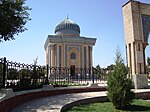Yūsuf Balasaguni
Yusuf Balasaguni | |
|---|---|
 As shown on the Kyrgyz 1000 som note | |
| Born | Yusuf c. 1019 |
| Died | 1077 (aged 57–58) Kashgar, Kara-Khanid Khanate |
| Nationality | Karakhanid |
| Occupation | Philosopher, Theologian, Vizier, Statesman |
Notable work | Kutadgu Bilig |
Yusuf Khass Hajib Balasaguni (Arabic: يوسف خاصّ حاجب, Yūsuf Khāṣṣ Ḥājib Balasağuni; Kazakh: Жүсіп Баласағұни; Uighur: يۈسۈپ خاس ھاجىپ; Kyrgyz: Жусуп Баласагын; Uzbek: Yusuf Xos Hojib) was an 11th-century Central Asian Turkic poet, statesman, vizier, Maturidi theologian and philosopher from the city of Balasaghun, the capital of the Kara-Khanid Khanate in modern-day Kyrgyzstan. He wrote the Kutadgu Bilig and most of what is known about him, comes from his own writings in this work. He is also referred to as Yūsuf Balasaguni, derived from his city of origin.
Background[]
Balasaguni's birthplace Balasagun was located at the Burana archaeological site near the present-day city of Tokmok in Northern Kyrgyzstan. His birthdate is estimated to be 1018[2] or 1019.[3] His father was one of the prominent and wealthy people of that time. The young poet received his primary education in his hometown. His main influences were Avicenna, Al-Farabi and Ferdowsi.
At the age of 54 (either in 1069 or 1070), Yusuf completed his work, "Kutadgu Bilig" ("Blessed Knowledge"). He wrote, as he called it himself, in the Turkic language of the Karakhanid era.
Kutadgu Bilig was the first work written in the language of the Muslim Turks during the Muslim Renaissance, as evidenced by the words of the poet at the beginning of the poem:[4]
- arabça tejikçe kitâblar üküş,
- biziñ tilimizçe bu yumğı ukuş.
- biliglig bilür ol munıñ hürmeti,
- ukuşluğ ukar ol bilig kıymeti...[5]
Translation:
- Yes, the Arabs, Tajiks have a lot of books,
- As for our speech, this is only the beginning.
- Who is wise will appreciate this book with respect,
- Who has matured with reason, appreciates knowledge...
Many Turkic-speaking peoples can rightfully consider this work as the source or the first masterpiece of their written literature of the Muslim era.
Some authors believe that Yusuf allegedly died at the age of 55 and was buried in the southern part of the city of Kashgar.[6] However, there are no direct historical sources about the date and place of death of Balasaguni.
Kutadgu Bilig[]
Balasaguni started to work on the Kutadgu Bilig (Middle Turkic: Wisdom of Royal Glory) in Balasagun and was about 50 years old when he completed it in Kashgar.[7] After presenting the completed work to the Karakhanid Hasan ibn Sulayman (father of Ali-Tegin) - Prince of Kashgar he was awarded the title Khāṣṣ Ḥājib, an honorific similar to "Privy Chamberlain" or "Chancellor". Some scholars suspect that the prologue to the Kutadgu Bilig, which is much more overtly Islamic than the rest of the text, was not written by Yūsuf, particularly the first prologue, which is in prose, unlike the rest of the text. He died and was buried in Kashgar, 1077.
The following is the excerpt from the Kutadgu Bilig; the first column is the text in the original (Karluk or Middle Turkic) language, but transliterated into Turkish (Latin) letters. Second column is the text's Turkish translation,[8] while the third one is its English translation.
|
|
|
Memory[]
- A monument in Bishkek, Kyrgyzstan
- Kyrgyz National University was named after Yusuf Balasaguni in 2002.
- A number of streets in Kyrgyzstan bears his name.
- The image of Balasaguni is present on the banknote of the Kyrgyz national currency of 1000 soms. Also, the National Bank of Kyrgyzstan issued commemorative coins for the anniversary (1000 years since the birth) of the poet.
- Streets in Tashkent, Andijan, Samarkand in Uzbekistan bear the name Yusuf Hass Hajib.
- 2016 was declared "Yusuf Hass Hajib Year" by International Organization of Turkic Culture.[9]
Tomb of Yusuf Balasaguni[]
The mausoleum of the poet in Tainap, Kashgar was erected in 1865, but it was destroyed in 1972 during the Cultural Revolution and a school was built in its place.[10] After the death of Mao Zedong, the mausoleum was restored to its former location, and the school was transferred to another building. When restoring the mausoleum, several more unknown burials were discovered on its territory. The grave of Yusuf Balasaguni is decorated with inscriptions in Chinese, Arabic and Uyghur.
Gallery[]

A Monument of Balasaguni outside Kyrgyz National University

Mausoleum in Kashgar that was constructed for his alleged grave site

Introduction Board at Mausoleum

Portrait of Yusuf Khass Hajib at Mausoleum

Tomb of Yusuf Khass Hajib
References[]
- ^ Ümit Hassan, (1989), Osmanlı devletine kadar Türkler, p. 302 (in Turkish)
- ^ Dilâçar, Agop (1988). 900. [i.e. Dokuz yüzüncü] yıldön��mü dolayısıyle Kutadgu bilig incelemesi (in Turkish). Türk Dil Kurumu. p. 21.
- ^ Yūsuf (Khāṣṣ-Hājib); Arat, Reşit Rahmeti (1979). Kutadgu bilig (in Turkish). Türk Dil Kurumu. pp. XXIII.
- ^ Kutadgu Bilig: (Blessed Knowledge). Yusuf Balasaguni. Moscow., "Nauka", 1983. p. 11
- ^ Yusuf Has Hacib. Kutadğu Bilig. Translated by Mustafa S. Kaçalin. T. C. Kültür ve Turizm Bakanlığı Kütüphaneler ve Yayımlar Genel Mudürlüğü. p. 7. ISBN 978-975-17-3359-7.
- ^ "Blessed Knowledge" of Yusuf Balasaguni. "Sodruzhestwo" Newspaper, № 13-14. International Council of Rerikh Organizations named after S. N. Rerikh
- ^ Devereux, Robert (1985). "Yūsuf Khāss Hājib, Wisdom of Royal Glory (Kutadgu Bilig): A Turko-Islamic Mirror for Princes, Robert Dankoff, trans., Publications of the Center for Middle Eastern Studies, No. 16 (Chicago: University of Chicago Press, 1983). Pp. 291". International Journal of Middle East Studies. 17 (4): 577–579. doi:10.1017/S002074380002972X. ISSN 1471-6380.
- ^ Balasaguni, Yusuf. "Kutadgu Bilig".
- ^ "Yusuf Khas Hajib Year Opening Ceremony was Held in Istanbul | Türk Dünyası Belediyeler Birliği". Retrieved 2019-10-22.
- ^ Millward, James A. (2010). Eurasian Crossroads: A History of Xinjiang. Hurst. p. 54. ISBN 9781849040679.
Links[]
- "Uzbek literature: The classical period". Encyclopædia Britannica. 2012.
- 11th-century poets
- Scribes
- Uyghur poets
- 11th-century Turkic people
- 1010s births
- Hanafis
- Maturidis





